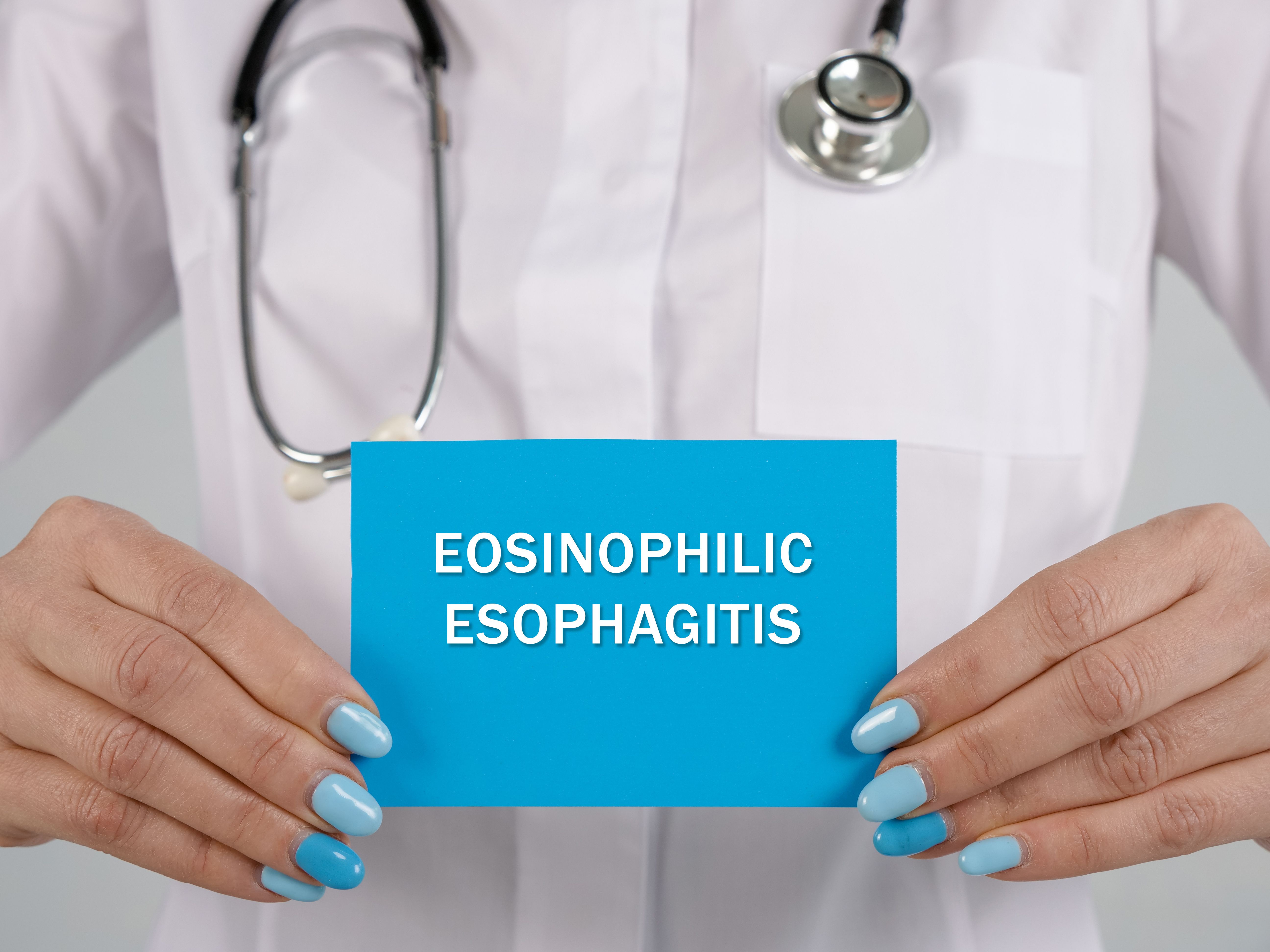- Center on Health Equity & Access
- Clinical
- Health Care Cost
- Health Care Delivery
- Insurance
- Policy
- Technology
- Value-Based Care
Treatment Demonstrates Histologic, Endoscopic Improvement in Pediatric Patients With EoE
Results showed higher-exposure dupilumab met the study’s primary endpoint for peak esophageal intraepithelial count ≤6 eos/high-power field.
This article was originally published by HCPLive.
Dupilumab may be a safe and effective treatment for pediatric patients with eosinophilic esophagitis (EoE), according to findings through week 52 of the phase 3 EoE KIDS trial.
Presented in a late-breaking abstract at the American College of Gastroenterology (ACG) 2023 Annual Scientific Meeting in Vancouver, results showed higher-exposure dupilumab met the primary endpoint of peak esophageal intraepithelial count of ≤6 eos/high-power field and demonstrated significant and clinically meaningful changes in histologic, endoscopic, and transcriptomic measures of EoE vs placebo in children aged 1-11 years.1
Eosinophilic Esophagitis inscription on sheet | image credit: Yurii Kibalnik - stock.adobe.com

“EoE has similar underlying histology in children and adults. However, children have more heterogeneous and non-specific symptoms, with less dysphagia and less remodeling than adults. There are no approved treatments for EoE in children aged <12 years,” wrote investigators.1
On May 20, 2022, the US Food and Drug Administration (FDA) approved dupilumab for EoE in adults and pediatric patients at least 12 years of age weighing at least 40 kilograms, marking the first FDA approval of a treatment for EoE.2 There are currently no approved treatments for EoE in children aged less than 12 years.1
A randomized, double-blind, placebo-controlled study, EoE KIDS assessed the safety and efficacy of dupilumab compared to placebo in pediatric patients with active EoE. To be included in the study, patients were required to be aged 1–11 years, unresponsive to at least 8 weeks of proton pump inhibitor treatment, have peak intraepithelial eosinophilic count of at least 15 eos/hpf in at least 2 esophageal regions, and have symptoms of EoE in the month prior to screening. In total, 102 patients were enrolled in the study.1
The 3-part trial included a 16-week placebo-controlled treatment period (Part A), a 36-week extended active treatment period (Part B), and a 108-week open-label extension period (Part C). In Part A, participants were randomized in a 2:2:1:1 ratio to receive weight-tiered, subcutaneous dupilumab on a higher-exposure or lower-exposure regimen, or placebo. Following a 12-week screening period, 37 participants were assigned to higher-exposure dupilumab, 31 to lower-exposure dupilumab, and 34 to placebo.1
Patients who completed Part A were eligible to enter a 36-week, extended active treatment period in Part B. Among the cohort, 37 participants taking higher-exposure dupilumab, 29 taking lower-exposure dupilumab, and 34 taking placebo. Data for patients assigned to higher-exposure dupilumab and placebo was presented at ACG by Mirna Chehade, MD, MPH, director of the Mount Sinai Center for Eosinophilic Disorders.1
In the higher-exposure dupilumab group, 24.3% of participants were female and the mean age was 6.8 (Standard deviation [SD], 3.1) years. In the placebo group, 26.5% of participants were female and the mean age was 7.2 (SD, 3.0) years. Investigators pointed out both groups had an increased level of atopic comorbidities (94.1% placebo vs 100% dupilumab).1
Upon analysis, the higher-exposure dupilumab group met the primary endpoint of peak esophageal intraepithelial eosinophil (eos) count ≤6 eos/high-power field (hpf) compared to placebo at week 16 (least squares mean difference vs placebo, 64.5; 95% confidence interval [CI], 48.19-80.85; P < .0001). At week 52, 62.9% of participants receiving higher-exposure dupilumab in Parts A and B and 52.9% of participants who switched from placebo in Part A to higher-exposure dupilumab in Part B achieved peak eos/hpf ≤6.1
Investigators pointed out the following measures improved from baseline to week 16 with higher exposure dupilumab vs placebo:
- EoE-Histologic Scoring System grade and stage scores (–0.88 and –0.84 vs +0.02 and +0.05, both P < .0001)
- EoE-Endoscopic Reference Score (–3.5 vs +0.3, P < .0001)
- Change in body weight for age percentile (+3.09 vs +0.29)
- Numeric improvement in caregiver-reported proportion of days experiencing ≥1 EoE sign (–0.28 vs –0.17)
Of note, improvement in these endpoints was maintained or increased with continued higher-exposure dupilumab through week 52. Improvements were also observed in patients on placebo who switched to higher-exposure dupilumab in Part B.
- EoE-Histologic Scoring System grade and stage scores (–0.97 and –0.89 for higher-exposure dupilumab in Parts A and B; –0.89 and –0.86 for higher-exposure dupilumab in Part B only)
- EoE-Endoscopic Reference Score (–4.38 for higher-exposure dupilumab in Parts A and B; –3.6 for higher-exposure dupilumab in Part B only)
- Change in body weight for age percentile (+5.96 for higher-exposure dupilumab in Parts A and B; +5.48 for higher-exposure dupilumab in Part B only)
- Mean proportion of days experiencing ≥1 EoE sign (0.13 for higher-exposure dupilumab in Parts A and B; 0.14 for higher-exposure dupilumab in Part B only)
At week 16, adverse events including COVID-19, rash, headache, and injection site erythema were more frequent among participants taking dupilumab compared to those taking placebo. Investigators noted the safety profile was similar through week 52.1
“Higher-exposure dupilumab met the primary endpoint of peak esophageal intraepithelial count ≤6 eos/hpf vs placebo and demonstrated significant and clinically meaningful changes in histologic and endoscopic outcomes, and improvements in clinical symptoms and rate of weight gain. Benefits were maintained or increased to W52 with continued treatment,” concluded investigators.1
References
- Chehad M, Dellon ES, Spergel JM, et al. 373 - Dupilumab Improves Histologic and Endoscopic Aspects of Eosinophilic Esophagitis (EoE), as Well as Rate of Weight Gain, in Children Aged 1 to <12 years: 52-week Results From the Phase 3 EoE KIDS Trial. Paper presented at: ACG 2023 Annual Scientific Meeting. Vancouver, Canada. October 20 – 25, 2023.
- FDA. FDA Approves First Treatment for Eosinophilic Esophagitis, a Chronic Immune Disorder. Press Announcements. May 20, 2022. Accessed October 26, 2023. https://www.fda.gov/news-events/press-announcements/fda-approves-first-treatment-eosinophilic-esophagitis-chronic-immune-disorder
